| Introduction | Text: The Field Trip | Images: On-Site | Images: Fossil Plants |
| Links: My Music | Links: My Fossils Pages | Links: USGS Papers | Email Address |
|
Visit a remote fossil leaf locality in Nevada where some 42 species of 38 to 39-million-year-old plants have been identified from the upper Eocene Dead Horse Tuff. Find superior examples of carbonized leaves preserved in sedimentary rocks that contain substantial quantities of volcanic ash. For folks unfamiliar with the rules and regulations regarding the collection of fossil specimens and other resources on Public Lands, visit the informative Bureau of Land Management (BLM) online brochures, Fossils On America's Public Lands and Collecting On Public Lands. |
|
Fossil enthusiasts looking for a remote and scenic area in which to find an abundance of well-preserved leaves, seeds, and twigs might want to try Copper Basin in Nevada. It's a famous paleobotanical locality that yields up some of Nevada's most reliably spectacular fossil plant remains. The fossil site lies within a geologic rock formation called the Dead Horse Tuff, which is late middle to upper Eocene in age, dated by radiometric means at some 45 to 37 million years old. For the most part the Dead Horse Tuff is an unfossiliferous unit of pyroclastic debris, a crystal vitric tuff ranging in mineral composition from a biotite rhyolite to a biotite horneblende latite some 2,600 feet thick. But near the middle of the extensive accumulation of solidified volcanic ash--the remnants of a series of devastating explosive eruptions throughout Eocene times--minor interbeds of tuffaceous shales up to 195 feet thick yield a treasure-trove of beautifully preserved deciduous leaves, conifer and maple samaras (winged flying seeds), and conifer foliage (primarily twigs, though cones and cone scales have been reported) roughly 38 to 39 million years old. The leaves in particular are typically preserved as bountiful carbonized impressions, organic tissues compressed through geologic time to shades of dark brown to black on a pale reddish-brown matrix. And because they are so spectacularly preserved, ranking as some of the finest examples of fossil plants in all the state of Nevada, many Dead Horse Tuff specimens have begun to appear in the inventories of commercial fossil dealers throughout the Western states. This is of course illegal activity, since no fossil specimen collected on Public Lands may be either sold or bartered; and the Copper Basin locality definitely lies amidst such a Bureau of Land Management-administered region. Accordingly, commercial collectors must stay away from Copper Basin, or the entire fossil-bearing area will most certainly be closed down to all but professional paleobotanists representing either an accredited university or museum. The usual admonitions might sound familiar to many regular travelers of the Great Basin, even laughably repetitious perhaps, but it is critical to remember that Copper Basin lies well off the proverbial beaten track. This is what the locals call the southeastern sector of "Owyhee Country," a sparsely populated Great Basin outback, if you will, where immediate medical or mechanical assistance is nonexistent. You may be able to find a ranch house somewhere out there, but don't count on it in a dire emergency. So, in order to assure a safe and enjoyable visit, those planning to visit the fossiliferous exposure of Dead Horse Tuff at Copper Basin must do so only in a reliable four-wheel-drive vehicle--or, at the very least, a rugged pickup truck whose tire tread can be trusted to carry you over lonesome stretches of semimaintained and unimproved dirt roads subject to washboarding, potholing, and sudden washouts. You should also expect to encounter a variety of jagged rocks that tend to ruin even the toughest of tire treads: keep your speeds moderate to slow; there is nothing worse than blowing out more than one tire during a backcountry trek. Once within the deep backcountry, still many a mile from Copper Basin, visitors will have an opportunity to observe the old site of Charleston, formerly one of the most isolated and lawless mining towns in all of Nevada. Nothing remains now to mark the site, save perhaps a couple of crumbling wooden buildings, but in a broader historical perspective Charleston has much to offer. Its general history has been discussed by many Nevada ghost town enthusiasts, including such notables as Stanley W. Paher and the inimitable Nell Murbarger, who in her classic work Ghosts Of The Glory Trail gives a riveting account of one of the last lynchings to take place in this part of the Great Basin--it happened in Charleston. The story has been told many time over; I hesitate to attempt another rendering of it here, but as I have already suggested the subject, I might as well join the prodigious body of folk who have already related the tale. Bear in mind that nobody has yet written the definitive account of what happened in Charleston in the 1880s. The general idea is that one George Washington Mardis, a Bible-thumping Old Testament preacher who gave stentorian sermons to his favorite burro "Sampson" made more-or-less regular trips from Charleston to a rather distant community for supplies. Prior to one his scheduled journeys, a local Chinese miner gave him $250 in gold to deliver to the community in payment of a debt. Mardis obliged--but it was the last favor he would ever do for anyone on this earth. The next day miners from Charleston found his wagon and team of horses abandoned along the road, below town. In the dry, dead brush nearby they also came upon his remains, riddled with bullet holes. Apparently word had spread to the local criminal element (and there was no short supply of that commodity in Charleston) that Mardi was carrying with him that extra gold worth 250 spondulix. A few of the miners at the scene of the crime decided to take a look around, playing amateur sleuth, to see what might turn up. When one of them spotted near the body the tracks of a barefooted individual bearing six toes on the left foot, the search for the perpetrator immediately turned to the Chinese quarter in Charleston. The logic went something like this: Nobody, the investigators averred, but a person of Chinese ancestry would possibly go around without shoes in that harsh, unforgiving Nevada climate. Thus, a vigilante posse swooped down on Chinatown, yanking slipper after slipper from the left feet of everyone they happened to encounter. Eventually, after running through scores of normal feet, they came upon one lone male who exhibited that distinctive and incriminating extra toe. The case was closed. They gave the six-toed individual two full days to devise any possible alibi; when none was forthcoming, the man was swiftly convicted on circumstantial evidence. The next day a suitable length of rope was procured and fashioned into the hangman's noose. And with most of the population of Charleston looking on--or taking part, as some accounts of the execution suggest--George Washington Mardis' murder case came to an inevitable ending. Once beyond Charleston, having susccessfully manuevered to Copper Basin through additional inspiring expanses of pristine sagebrush paradise, one is well-ready for some paleobotanical investigations--AKA: let's start digging. The best way to find fossils at Copper Basin is to split with great care the partially silicified reddish-brown to creamy-white ashy shales of the upper Eocene Dead Horse Tuff. Remove large chunks of the shales from the outcrop and, using either the pick or blunt end of a geology hammer (or even a broad putty knife, though a selection of large and small chisels would be a better idea here), forcefully rap the shales along their natural bedding planes. Usually, they will split with surprising ease to reveal a rewarding assortment of carbonized plant remains. Some 42 species of fossil plants have been identified from the Dead Horse Tuff at Copper Basin. The most abundant forms encountered are fragmentary and, occasionally, complete leaves belonging to a species of alder called Alnus jarbidgiana. In decreasing order of abundance, the nine next most-common remains include: an extinct redwood, Sequoia affinis (which is closely related to the modern coast redwood of northwestern California); leaves, from a tanbark oak; seeds, cone scales, and twigs from a spruce; twigs from a second type of spruce; leaves from an Oregon grape; samaras and twigs from a fir, Abies cuprovallis; a second species alder, Alnus cuprovalis; and leaves from a sassafras, Sassafras ashleyi. Also present, but rather rarely found, are such varieties as cypress, hawthorn, plum yew, pine, maple, rhododendron, Prunus sp. (four species), eastern wahoo, buckeye, larch, willow, tree sparkleberry, madrone, currant, ocean spray, rose, and leadplant. It may come as no surprise to students of paleobotany that the first scientist to collect at Copper Basin was none other than the late Dr. Daniel I. Axelrod, who for decades was one of the better recognized paleobotanists in the world. After learning of the locality through a private collector in Elko, Axelrod and his field assistant James F. Ashby made their first visit to Copper Basin in the spring of 1939. Axelrod said that they made only a small collection of plants on that date, due to the fact that the ground was still way too damp from the thawing snow pack of the previous winter. Subsequent visits in the summers of 1956, '59, and '61 through '63 netted a total of 5,343 specimens from the upper Eocene Dead Horse Tuff--all of them now housed in the archival paleobotanical repository at the University California Museum of Paleontology. Eventually, Axelrod published his findings in a formal peer-reviewed paleobotanical treatise, monograph. That's where he concluded that the fossil flora most closely resembled a number of modern conifer forests present in the western United States--among them the coast redwood and spruce-hemlock forest of northwestern California, in addition to the spruce-larch forests of the northern Cascade and Rocky Mountains. He also saw some obvious relationships to the spruce-fir and regional conifer-deciduous hardwood forests of the eastern United States and their similar, counterpart, forest-type associations in China and Japan. Based on the environmental preferences of modern analogs of species identified from the Dead Horse Tuff, Axelrod suggested that the Copper Basin Flora originated from a conifer-hardwood deciduous forest that lived close to the zone of montane conifers. Initially, Axelrod estimated that elevations at the site of deposition were probably in the neighborhood of some 3,600 feet; today the fossil site lies at 7,150 feet in a region regularly hit with wintertime weather extremes reminiscent of an Arctic environment. Yet, approximately 38 to 39 million years ago the late Eocene climate could best be described as cool-temperate, with roughly 50 to 60 inches of rain per year--and that well distributed throughout the summer. There was no snow, except on the higher peaks surrounding the basin of deposition. The average yearly temperature was somewhere around 51 degrees, with mean temperatures for the warmest and coldest months of the year at around 58 and 44 degrees, respectively. It's interesting to note that Axelrod's Copper Basin paleo-elevation analysis went pretty much unchallenged for many years, until the late paleobotanists Howard Schorn and Jack A. Wolfe, among numerous other investigators, concluded through several avenues of independent scientific research (including a rigorous, sophisticated leaf character analysis study) that the entire ancestral Great Basin region--that is to say, that vast area that includes extreme eastern California, virtually all of Nevada, parts of southeastern Oregon, a slice of southern Idaho, and some of western Utah (Millard County, in particular)--likely existed during middle to late Eocene times as a broad plateau (the so-called Nevadaplano) that stood nearly as high, if not higher, than those elevations observed today. At that early Cenozoic time in ancestral Nevada, around 45 to 37 million years ago, several river valleys incised into a predominantly igneous terrain occasionally became filled with pyroclastic material derived from periodic pulsations of violent volcanic activity. Situated on the eastern side of the middle Eocene paleodivide that ran north-south through Nevada about midway between today's Battle Mountain and Elko, one of those ancient paleovalleys at Copper Basin, estimated to have been some 3,280 feet deep, held a watercourse that drained eastward in the general direction of the Wasatch Plateau in Utah. Approximately 40 million years ago, abundant ash and associated ignimbrites from a series of volcanic eruptions choked the Copper Basin channel, damming the watercourse, concomitantly creating late Eocene Dead Horse Lake, within which plant structures, muddy debris, and tuffaceous detrital constituents accumulated roughly 39 to 38 million years ago in a localized lacustrine shale facies of the Dead Horse Tuff. Many years after Axelrod first described the Copper Basin paleobotanical treastures in an excellent monograph, Schorn and Wolfe estimated that the Copper Basin plants accumulated at elevations only slighly lower than those observed today--in other words, approximately 6,500 feet, although a later scientific paper suggested that the Eocene area could have stood as high as 11,000 feet. Ultimately, though, through geophysical strains of extension and block faulting during the Miocene Epoch, elevations throughout the Great Basin had collapsed, dropped, to around the same as today's heights by late Miocene times, some 6.8 million years ago. It was certainly a different world at Copper Basin some 38 to 39 million years ago--a broad lake basin within which volcanic ash periodically mixed with the fallen debris from deciduous plants and conifers to form a richly fossiliferous horizon in the Dead Horse Tuff. Today, collectors pry apart the hardened tuffaceous muds on a weathered ridge some 7,150 feet high in the glorious isolation of Nevada, finding a wealth of beautifully preserved fossil plants--a direct link with an age when a now extinct variety of coast redwood towered above thickets of alder, and the harshness of modern winters was yet to come. |
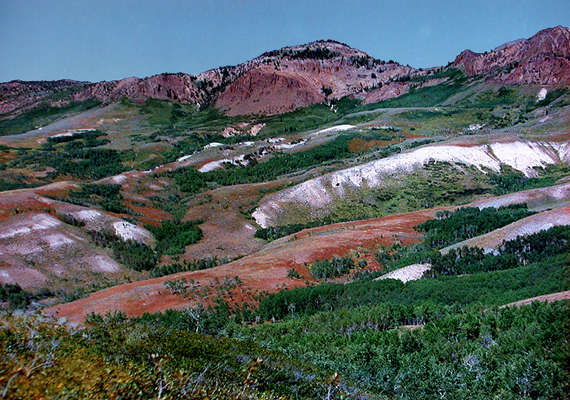
| Click on the image for a larger picture. The view is northwest across scenic Copper Basin. Note the prominent outcrops of whitish tuffs of the F Eocene Dead Horse Tuff lying below the more massive reddish-brown middle Miocene Jardbidge Rhyolite, dated by radiometric methods to 15.5 million years old. Local concentrations of beautifully preserved, carbonized 38 to 39-million-year-old leaf impressions occur within minor tuffaceous shale accumulations interbedded in the predominantly volcanic terrain. |
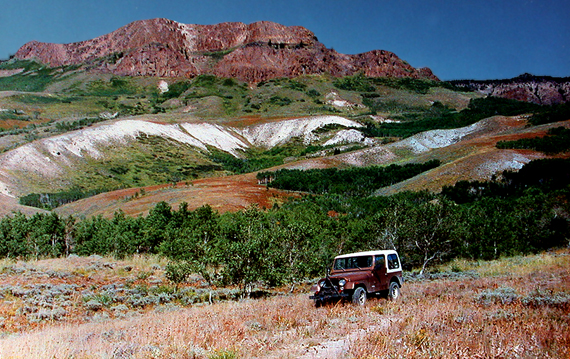
| Click on the image for a larger picture. The view is roughly north, parked amidst Copper Basin, where some 42 species of fossil plants occur in tuffaceous, lacustrine (lake-deposited) exposures of the upper Eocene Dead Horse Tuff (38 to 39 million years old), which here extends from bottom of photograph to the base of the reddish-brown, 15.5 million year old middle Miocene Jarbidge Rhyolite at skyline. |
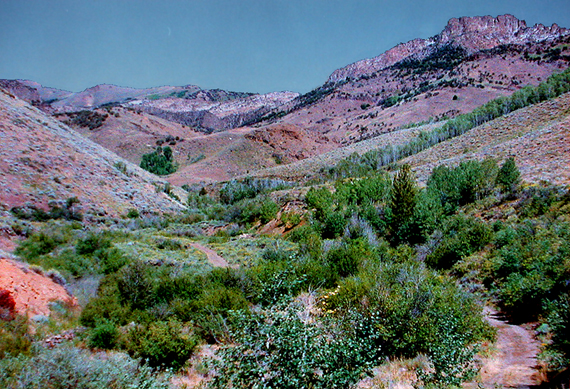
| Click on the image for a larger picture. The view is roughly north to the pristine Alpine setting in Copper Basin, where some 42 species of fossil plants occur in tuffaceous, lacustrine (lake-deposited) exposures of the upper Eocene Dead Horse Tuff (38 to 39 million years old). Most rocks within view are Eocene-Oligocene volcanics--except for that prominent peak at upper right, which is the 15.5 million year old Jarbidge Rhyolite. |
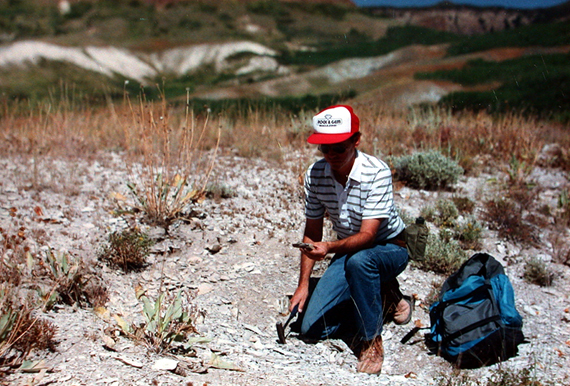
| Click on the image for a larger picture. Looking roughly northward from a fossil leaf locality in the upper Eocene Dead Horse Tuff. A paleobotany enthusiast searches for plant fossils. Here, near the middle of the thick predominantly pyroclastic section, minor interbeds of fine-grained, tuffaceous lacustrine shales up to 165 feet thick yield an abundance of excellently preserved fossil plants 38 to 39 million years old. |
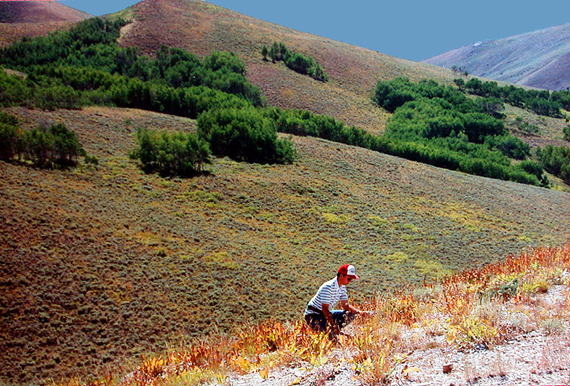
| Click on the image for a larger picture. A fossil seeker explores the fine-grained Dead Horse tuffaceous shales at Copper Basin, Nevada. The view is roughly westward across a fossil plant locality in the upper Eocene Dead Horse Tuff that yields some 42 species of 38 to 39 million year-old paleobotanical material. |
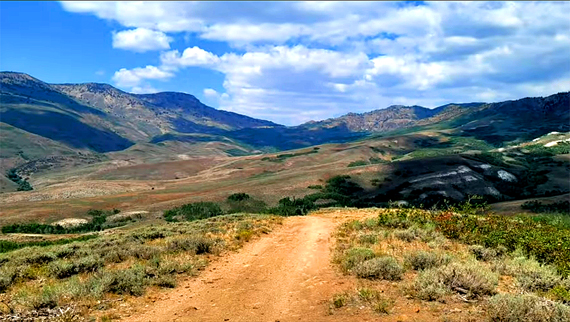
| Click on the image for a larger picture. An overview of the Copper Basin area, Great Basin, Nevada. Note the whitish exposures of the upper Eocene Dead Horse Tuff at middle far right, Cenozoic Era deposits that locally yield to paleobotanical investigations roughly 42 species of 38 to 39 million year old leaves, seeds, needles, and cones preserved as aesthetically pleasing dark brown to black carbonized impressions along the bedding planes of minor tuffaceous shales interbedded within a predominantly volcanic terrain. A screen shot from a video uploaded to YouTube by Wonderhussy Adventures; I edited and processed the image through photoshop. |
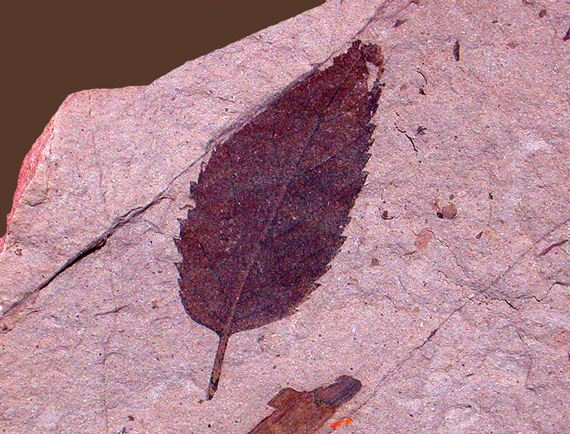
| Click on the image for a larger picture. Here is a complete leaf from a species of alder, Alnus jarbidgiana, the most common fossil plant variety encountered in the upper Eocene Dead Horse Tuff at Copper Basin, Nevada. The specimen is 38 to 39 million years old. |
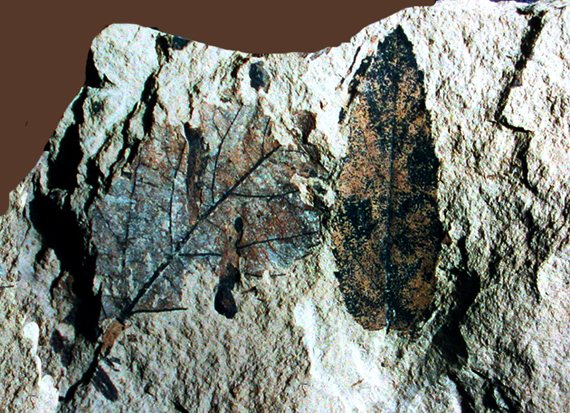
| Click on the image for a larger picture. Here are two fossil leaves from the upper Eocene Dead Horse Tuff, Copper Basin, Nevada: at left is a fragmentary specimen of an alder, Alnus cuprovalis; at right is a complete leaf from the alder, Alnus jarbidgiana--both specimens are among the most common plant remains recovered from the Dead Horse Tuff. The carbonized leaves are 38 to 39 million years old. |
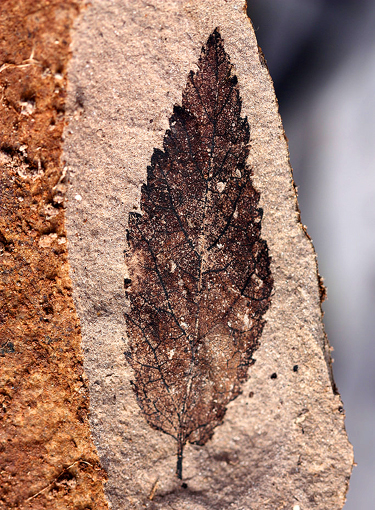
| Click on the image for a larger picture. A complete fossil leaf from the upper Eocene Dead Horse Tuff, Copper Basin, Nevada--from a genus-species of alder paleobotanists refer to as Alnus jarbidgiana. The leaf is 38 to 39 million years old. Photograph courtesy an individual who goes by the cyber-name of tenebboy. |
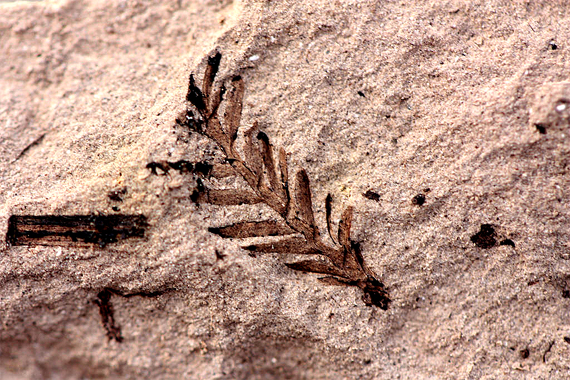
| Click on the image for a larger picture. Sequoia foliage from the upper Eocene Dead Horse Tuff, Copper Basin, Nevada--from an extinct genus-species of Sequoia paleobotanists refer to as Sequoia affinis. Photograph courtesy an individual who goes by the cyber-name of tenebboy. The paleobotanical specimen is 38 to 39 million years old. |

| Click on the image for a larger picture. A Sequoia twig from the upper Eocene Dead Horse Tuff, Copper Basin, Nevada--from an extinct genus-species of Sequoia paleobotanists refer to as Sequoia affinis, whose closest modernday counterpart is the coast redwood. The fossil plant is 38 to 39 million years old. A screen shot from a video uploaded to YouTube by Crime Pays But Botany Doesn't; I edited and processed the image through photoshop. |
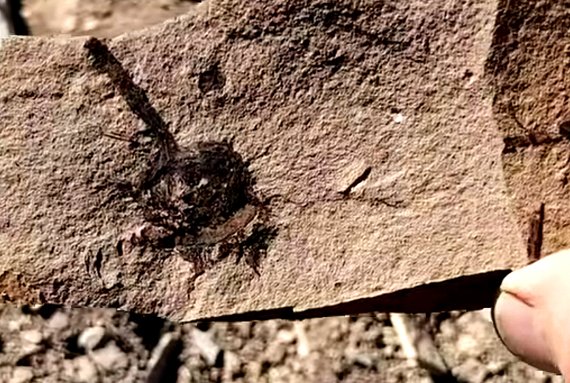
| Click on the image for a larger picture. A Sequoia cone from the upper Eocene Dead Horse Tuff, Copper Basin, Nevada--from an extinct genus-species of Sequoia paleobotanists refer to as Sequoia affinis, whose closest modernday counterpart is the coast redwood. The carbonized cone is 38 to 39 million years old. A screen shot from a video uploaded to YouTube by Crime Pays But Botany Doesn't; I edited and processed the image through photoshop. |
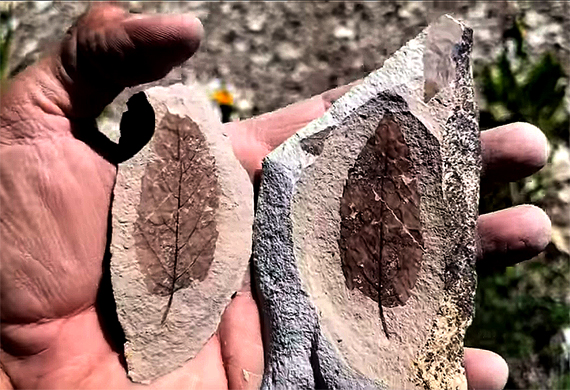
| Click on the image for a larger picture. Part and counterpart of a leaf from an alder paleobotanists refer to as Alnus jarbidgiana, the most common fossil plant species found in the 39 to 38 million year old upper Eocene Dead Horse Tuff, as exposed in the Copper Basin district, Great Basin, Nevada. The carbonized specimens are 38 to 39 million years old. A screen shot from a video uploaded to YouTube by Crime Pays But Botany Doesn't; I edited and processed the image through photoshop. |
|